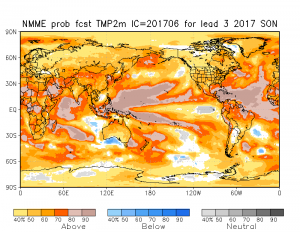Monsoon- Asia 2017
By Michael FaginMt. Everest WeatherAsian Monsoon Summer 2017. The present near neutral but above average ENSO state may shift into a weak El Nino this summer or fall. What does that mean for central Asia? When it does arrive, the phenomenon instigates underlying effects on the weather that have an established, intermittent history of drying the monsoon and thus devastating populations that rely upon it. This year, however, ocean water temperatures are not expected to impart particularly tragic effects – the monsoon’s strength is predicted to be only 2% less than average.
The impact of above average temperatures or an El Niño event on the Asian monsoon varies across the region. Oceania is expecting a moderately drier west and wetter east, with most of Australia looking notably drier. There has been up to 40% less rainfall over southern India. A few hundreds of miles to the north, the exact opposite is occurring. The Asian monsoon Summer 2017 is moving about a week faster than the mean time of arrival. Updates on the advancement of India’s monsoon. The hurried progression robbed southern India of some of its typical rainfall but it appears it will slow down over the mideastern side of the subcontinent.
Nepal and the central Himalayas are expected to see some of the moisture in what is shaping up to be a moderately wetter than normal summer there.
A Sneak Peek at Fall 2017
Heading into fall, will the slightly warm Indian Ocean get warmer? Current forecasts are predicting a potential for warming and the formation of a weak El Niño but a greater chance of remaining ENSO-neutral for the remainder of the year. The potential for warming will be assisted by the Indian Ocean Dipole shifting to positive, especially toward the end of 2017which facilitates a cooling of the ocean waters west of Indonesia and a subsequent windy push of warmer waters toward Africa.
Written by Meteorologist Geoff Linsley

Monsoon Asia 2017 impacts for summer and fall
